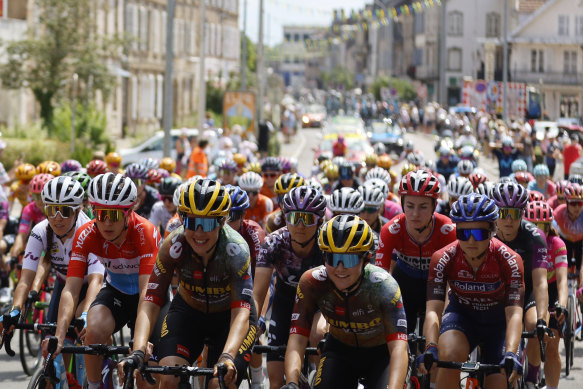The other time we need more output from the heart is when we are sick. “If you get COVID, or whatever, there’s a need for the body to provide more oxygen. The two times people develop what we call ‘heart failure’ is when they’re doing physical activity or when they’re unwell.”
He adds: “It’s a critically important thing. We have all these measures in cardiology about how strongly a heart pumps and how well it relaxes and yet a lot of it just comes down to the size of the heart.”

Generally, Tour de France cyclists have hearts that are twice as large as the average person.Credit:AP
So for the new study, published in the Journal of the American College of Cardiology, La Gerche and his colleagues tested the small heart concept.
They took 185 healthy women aged between 42 and 60, who ranged from sedentary to very fit, and evaluated their cardiorespiratory fitness (based on Vo2max) and then looked at the size and function of their hearts.
They focused on women because heart failure with preserved ejection fraction, where the heart pumps properly but still fails, is more common among women. Still, La Gerche says, the findings apply equally to men.
They found that heart size determines fitness. Given that separate research has determined that a lack of fitness is the strongest predictor of heart failure admissions, they are extrapolating and saying those with a small heart are more at risk of heart failure. “What we’re arguing and demonstrating with this research is that the strongest marker of that is the really simple measure of heart size,” he says.

The strongest influence on heart size and structure is exercise.Credit:iStock
Garry Jennings, a cardiologist and chief medical adviser for the National Heart Foundation, says it is a “really nice study”.
What it doesn’t show, however, is whether the study subjects were born with a small heart, and this puts them at a disadvantage, or they haven’t been doing much exercise.
“If you get more breathless than other people during exercise, you probably avoid it,” Jennings says. “There’s a real chicken-and-egg question here, but the observation is really strong and potentially really valuable.”
Loading
Valuable, because our hearts are plastic.
A famous study done in Dallas, in the late ’60s, found that after three weeks of being confined to a bed, the hearts of the healthy young male participants had shrunk by 30 per cent. The men had also lost 30 per cent of their fitness.
“We can do the opposite,” La Gerche says. “We can put people through an exercise program and their fitness improves, and their heart gets bigger. We forget that the strongest influence on heart size and structure is exercise. There’s no drug that can double your heart size.”
The most effective way to measure the size of our heart is via an ultrasound, however struggling to walk up a couple of flights of stairs, or an inability to keep up with our peers may also indicate a small or shrunken heart. Our resting heart rate may also be a clue, says La Gerche, pointing out that a very fit person might have a resting heart rate of around 40 beats per minutes while someone who is unfit, and likely to have a smaller heart, might be 90 to 100.
Loading
Although genetics also determines the size of our hearts and some people’s hearts are less responsive to exercise, physical activity is still important.
“If they don’t exercise their heart gets smaller quite rapidly,” La Gerche explains. “If they exercise, it can still get bigger, but it will be modest. It’s one of those sliding door moments. You take Jim or Dora and if they don’t exercise, in 20 or 30 years they’re going to be in real strife. If they do, they’re still not going to be at the Olympics, but they’ll be living a good life.”
Heart failure, he adds, has multiple causes. Heart size will not explain all of them, but may contribute to “a good chunk”. For this reason, he encourages doctors to consider heart size when a patient complains of being short of breath during exercise or says they can no longer keep up with people the same age.
“If you could identify small hearts in younger people who are on a trajectory towards that then that would be very, very useful and grounds for certainly recommending physical activity,” Jennings says.
By considering heart size, there’s the chance to prevent heart failure down the track, says La Gerche: “It’s almost like we’ve looked past the simplest thing which is just heart size.”
Make the most of your health, relationships, fitness and nutrition with our Live Well newsletter. Get it in your inbox every Monday.
For all the latest Life Style News Click Here
For the latest news and updates, follow us on Google News.
